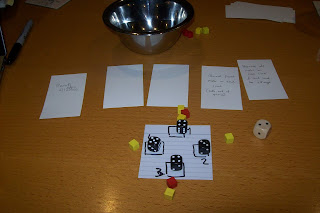Right at the end of November was the Dragonmeet convention in London, which I have attended for the last few years as part of the PlaytestUK team. We run an area for game designers to get their prototypes played by regular convention goers rather than the usual PlaytestUK meetups which are mostly designers playing each other's games. I spent the first few hours helping to staff the area, which largely involves inviting passing gamers to join a game. This is usually a bit hard going at the start of the day, but as time passes you get more people just turning up looking for something to play.
I had a slot for playtesting myself in the afternoon, and introduced Tom Coldron's game Elvic to two different groups. Things went very well overall, with players being well engaged, but a few issues were raised, largely relating to balance between certain options (some cards are perceived as strictly better or worse than others), which need to be at least considered. I've now sent the current play set back to Tom with some notes about how things have been going, so we'll see what he thinks.
| Elvic at Dragonmeet. |
Other than that, I got discussing a game idea with another of the designers there who was also volunteering at the same time as me. He had an idea about making a game that is largely about tactility and recognising items by the sense of touch alone, and our discussions moved towards a development of this. We've both been tinkering with this idea since, and have been communicating, and a basic version of a game is starting to form. Hopefully we'll be able to get together some time soon (we don't live too far apart) to see if we can develop things more in person.
Other than that it has been Scurvy Crew. I've not had playtesting opportunities on this, but I have worked a lot of ideas from discussions with BrainCrack into a new version of the prototype. The basic gameplay is not changing significantly, but we are working on the campaign mode, which allows you to play a series of games (we're planning 7, to match the 7 seas and all that) with development of threats and opportunities as you work through it. Plus, with the game being a relatively short one, the aim is to make it so that you can binge your way through the campaign in a day (maybe even an afternoon) should you wish. Anyway, I think the first official announcements about the game are likely to happen in the next couple of months, so we'll see how things go...
Anyway, I think this will be about it from me for the year. I hope you have a good Christmas or whatever else you might celebrate at this time of year. Back soon... :)


























